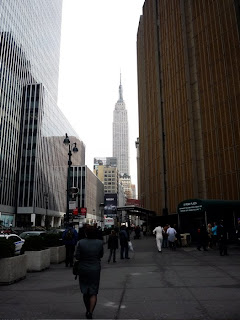Meditations on Light, Freedom, and Architecture: At Franklin D. Roosevelt Four Freedoms Park on a Sunday Afternoon
Franklin D. Roosevelt Four Freedoms Park, located at the south tip of Roosevelt Island, officially opened to the public on October 24, 2012, just a few days before the city was hit by Hurricane Sandy. What follows are pictures and thoughts from a visit to the park on the afternoon of Sunday, December 2, 2012.
The story of the park is long, but in short, architect Louis Kahn designed plans for this monument in the months before his death in 1974. After decades of unrealized plans and lack of financing, momentum to build Kahn's FDR memorial picked up a few years ago. Residents of Roosevelt Island were divided on whether or not this was a good idea. At the time, this site was a rare thing - a small, verdant patch of undeveloped land, a remnant of a primordial Mannahatta. Building on a green space in New York City with uncommon views of the surroundings was a tough decision. Especially if the thing in question was a big deal with many question marks.
Images by Walking Off the Big Apple from Sunday afternoon, December 2, 2012.
The story of the park is long, but in short, architect Louis Kahn designed plans for this monument in the months before his death in 1974. After decades of unrealized plans and lack of financing, momentum to build Kahn's FDR memorial picked up a few years ago. Residents of Roosevelt Island were divided on whether or not this was a good idea. At the time, this site was a rare thing - a small, verdant patch of undeveloped land, a remnant of a primordial Mannahatta. Building on a green space in New York City with uncommon views of the surroundings was a tough decision. Especially if the thing in question was a big deal with many question marks.
 |
An open room and New York City. That's Manhattan over there to the west. |
 |
Keep going to the vanishing point. |
 |
This huge bust of FDR on the right, impossible to discern in detail in this image, is by Jo Davidson (1883-1952). You may also know Davidson's sculpture of Gertrude Stein in Bryant Park. |
 |
(Insert your favorite inspiring thought here.)
|
 |
I think I can say without hesitation that this is the greatest public space ever to be built in the middle of the East River. |
______
Park hours are Thursday – Sunday, 9 am – 5 pm. www.fdrfourfreedomspark.org
Recommended transportation: The Roosevelt Island Tramway, the aerial tram that connects Manhattan and Roosevelt Island, offers sweeping views of the island, the East River, and the park.
Though sited on a vulnerable island in the East River, Franklin D. Roosevelt Four Freedoms Park was undamaged during Hurricane Sandy.
Images by Walking Off the Big Apple from Sunday afternoon, December 2, 2012.














I love the lines and all the silhouettes. Looks like a wonderful place to walk.
ReplyDeleteI agree with the author's assessment of the Louis Kahn design, but I have a small quibble with the description of the parcel of land it was built on:
ReplyDelete"a small, verdant patch of undeveloped land, a remnant of a primordial Mannahatta."
This was scrubby landfill before it was developed, not primordial at all.
SML,
ReplyDeletePoint well taken. I concede.
Just beautiful, Teri. And I love the Kahn quote! One of the things we've been seeking out of late on visits to New York are quiet little places to momentarily escape the noise and energy. I'm adding this park to my list.
ReplyDeleteThis post was so touching. I could 'feel' the place. Thanks for sharing.
ReplyDelete